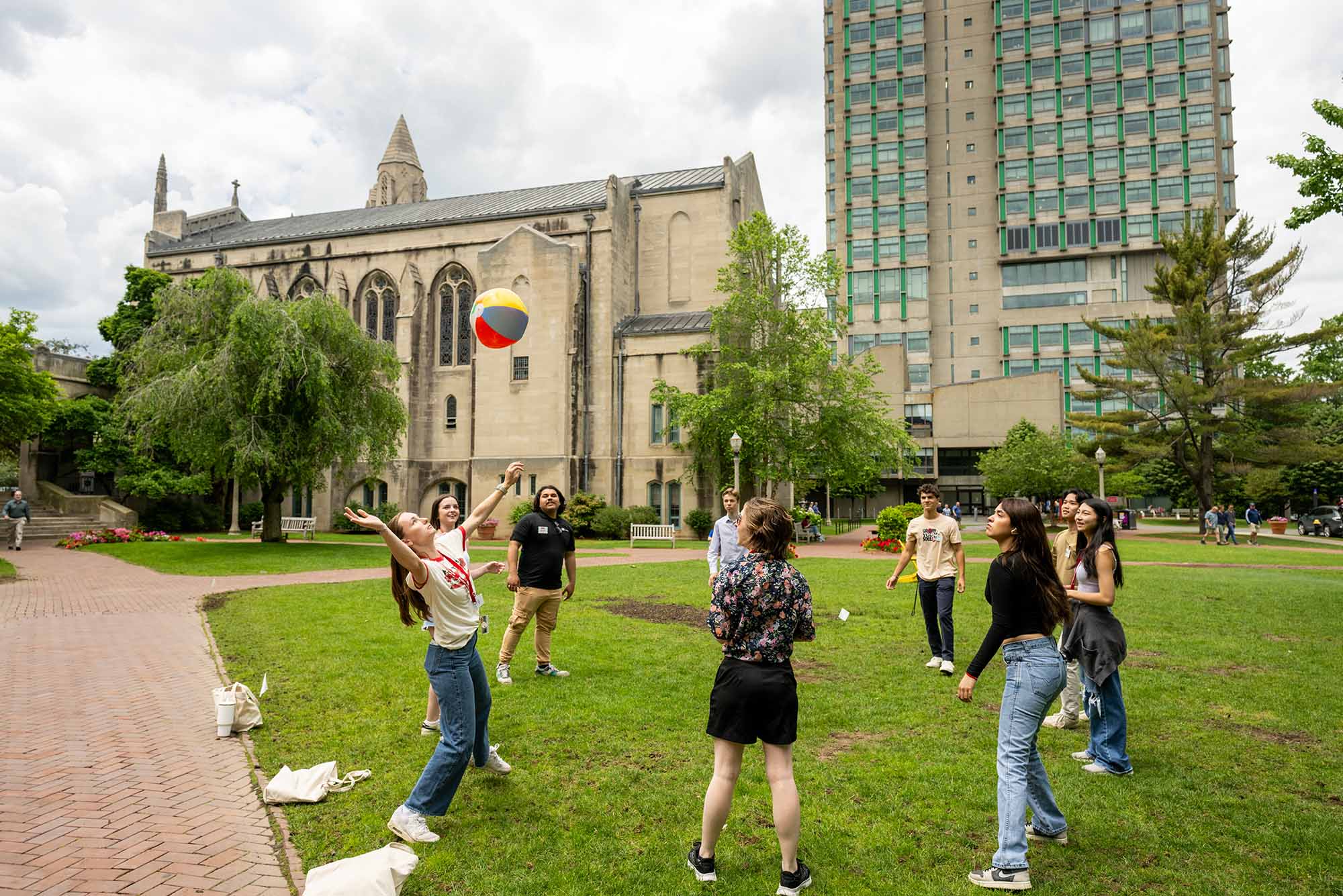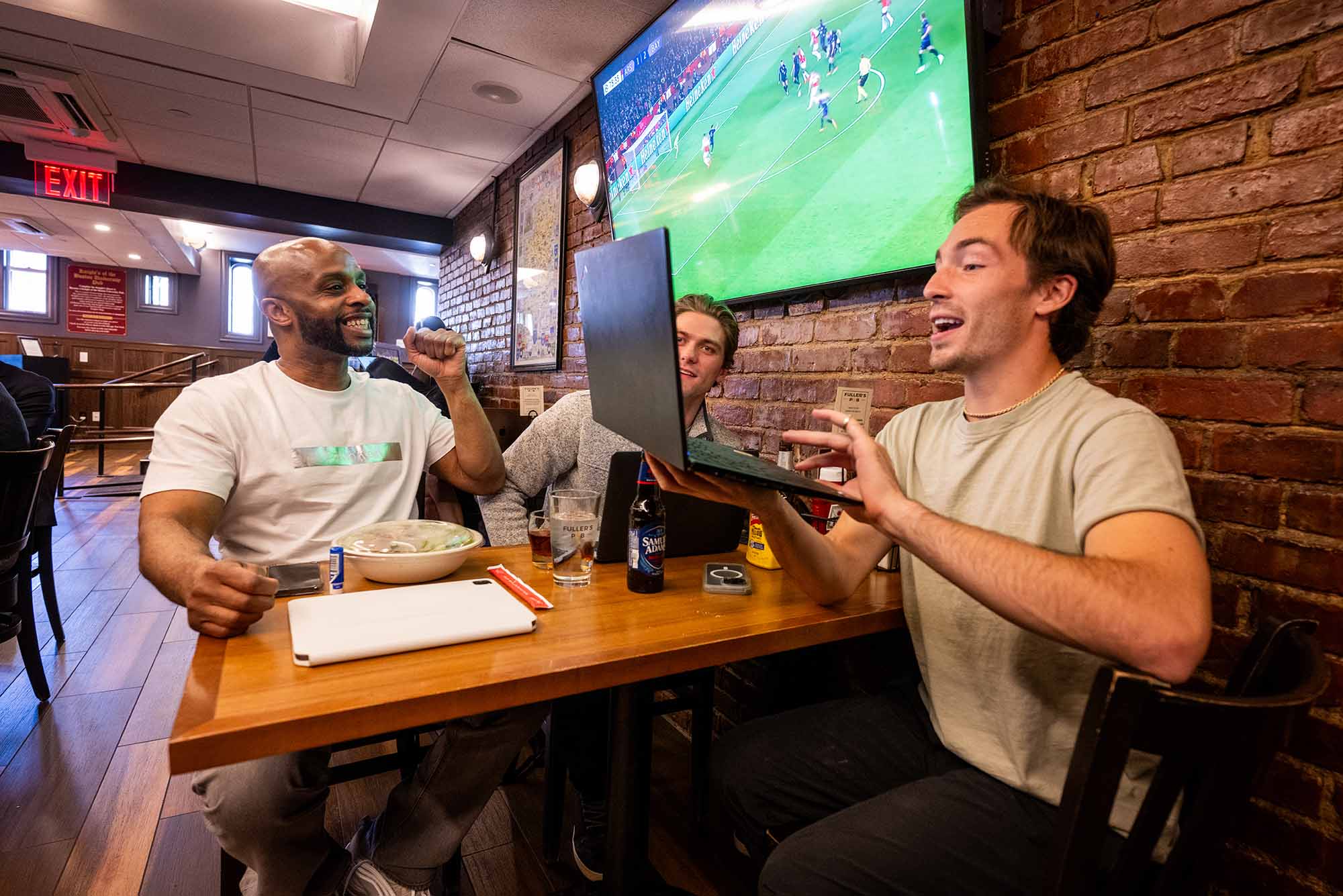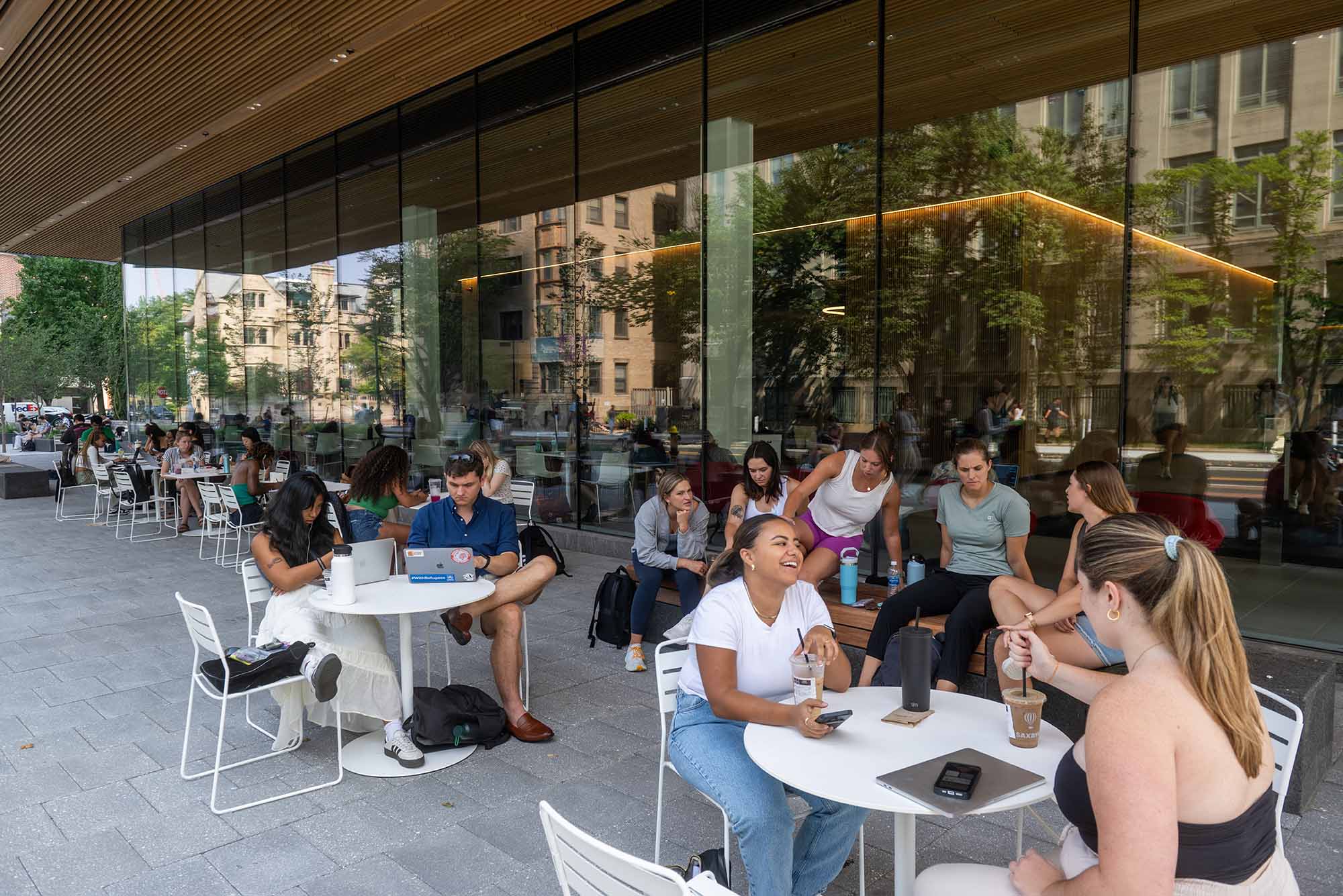Why Is Everybody Talking About “Third Places” Right Now?
It’s a space intended for socializing that’s neither work nor home. So what makes a third place so important?

One of the most popular gathering spots on campus, 270 Bay State Road—also known as the BU Beach—is the site of decades of freshman orientations, study sessions, courtships, friendships, and millions of conversations.
Why Is Everybody Talking About “Third Places” Right Now?
It’s a space intended for socializing that’s neither work nor home. So what makes a third place so important?
Libraries are a lot of things for a lot of people. They’re home to study sessions and gossip sessions, chance encounters and habitual meetups, social events and quiet reflection. At Boston University’s Mugar Memorial Library, clubs meet, event spaces are rented, on-campus services offer pop-ups, students study individually and in groups, and people find quiet refuge, says Michelle Neibur, BU’s head of access services and library experience. It’s free, available to anyone at BU, and open from 19 to 24 hours a day, depending on the season.
In a lot of ways, Mugar fills in the cracks of campus life: it’s not home, it’s not work or class, it’s the very definition of a growing cultural movement—it’s a third place.
“We recently had a station set up where students could write something they loved about the library on a slip of paper and make a chain,” says Kristina Bush, library experience manager. “What students said that they love about the library really speaks to envisioning the library as a third place—many of the comments were about community, friendship, and ‘the vibes.’”

What began as an academic concept—the term “third space” was coined by sociologist Ray Oldenburg to describe public gathering spaces found outside of work and home—has found purchase with people from BU librarians to TikTokers to Boston city councilors.
From the New York Times in February: “The value of public gathering spaces was well known, but there was no term for it. [Oldenburg’s] phrase took hold and remains popular.” As a phrase, the paper said, ”third places” turned up more than 2,500 times over a year in both academic and professional publications. During that time, the term has taken on different definitions and encompassed more and more territory. And while there’s a basic logic to the idea that people should have places to form affinity, the idea of protecting—and expanding—third places is touted as a radical solution to an avalanche of contemporary issues.
“I’ve always thought of third places in very general terms: places that aren’t home or work,” says Japonica Brown-Saracino, a BU College of Arts & Sciences professor of sociology. “I think it was important to Oldenburg that the term describe places where you are likely to encounter people you wouldn’t encounter in other domains, and where you can have informal social interactions. I think his theoretical formulation stands the test of time.”
Communities at risk
Brown-Saracino researches urban and community sociology, with a special focus on gentrifying communities within major American cities. Gentrification is an oft-mentioned ideological foil to the idea of third places; members of a community—a neighborhood, for instance—often feel that their favorite coffee shops and watering holes are jeopardized by urban redevelopment.
“Members of the professional classes will move into neighborhoods that were traditionally working class and displace longtime residents, and they also contribute to the transformation of the social and cultural character of the neighborhood,” she says. “Parks can change. Community health centers can get priced out of existence. Churches can get displaced. Mom-and-pop stores can be replaced by exclusive chains, and so on.”
If gentrification is not controlled and those mom-and-pop shops and community health centers are priced out, more than the identity of a neighborhood is lost. What all those third places have in common is their accessibility, Brown-Saracino adds—their openness to people from all walks of life.
“Ideally, these places should be open for long stretches of time, be relatively affordable, and cultivate the opportunity for informal interaction among strangers,” she says. Walkability and multimodality—a term referring, for example, to the ability of a coffee shop to also host open mic nights—also help. “If the goal is to sustain community and to allow people who might not otherwise cross paths to interact with one another, then you need to have all kinds of diversity in the space.”
Isolating the problem
Amid discussions of vanishing third places, the importance of community as a public health necessity is becoming understood. During the COVID-19 pandemic lockdown, when there were no concerts in the park or info sessions at the library, no impromptu trips to the bar or long conversations at the barbershop, America’s mental health suffered. Spikes of anxiety, depression, and substance use were reported, as well as a surge in reports of loneliness, once referred to as a “public health epidemic,” by former Surgeon General Vivek Murthy.

In March 2021, a Gallup poll reported that 25 percent of adult respondents felt lonely “a lot” of the day—for young people, it was almost 40 percent. In 2024, according to the American Psychiatric Association, 25 percent of US residents felt more lonely than they did before lockdown.
Since the return to public life, third places have struggled to recover. An existing lack of community infrastructure, plus a steady rise in social media consumption during the thick of COVID, saw places from movie theaters to concert venues to art galleries suffering and shuttering.
“Research shows again and again how important it is for people to know their neighbors, to not feel isolated, and to have the opportunity to build relationships,” Brown-Saracino says. “We need intimate, close relationships, but casual relationships serve a purpose as well, and many of those can be cultivated in a third place.”
Clinicians have noted that risks to loneliness are heightened in young people, along with anxiety and depression, Paul Cherchia and Chelsea Cobb, co-assistant directors of BU’s College Mental Health Education Programs, say. Cobb and Cherchia run NITEO, a program at the Sargent College of Health & Rehabilitation Sciences Center for Psychiatric Rehabilitation that works with students at BU and beyond who are on a mental health–related leave of absence. NITEO offers academic, emotional, and social skill-building as well as peer support and coaching.
“Long before the pandemic, the most common factor we saw leading to a leave of absence was isolation and loneliness and feeling disconnected.” Cherchia says.
“The sense of loneliness, that then created mental health challenges, has a trickle-down effect on {students’] emotional well-being,” Cobb adds. “I think we see that a lot of challenges start with students feeling isolated that they haven’t found their people.”
Cobb and Cherchia are advocates for taking advantage of a campus’ built-in third places. For BU students, they recommend finding religious community in places like Hillel and Marsh Chapel, as well as the Howard Thurman Center for Common Ground and the Newbury Center, which serves the University’s first-generation students and also opens certain events to the entire community. And, of course, the library.
“In general, public study spaces are a great alternative to studying in your bedroom or dorm—even if you’re not interacting with other people, at the very least you do feel a little bit more connected to the campus and the culture,” Cherchia says. “And our center is a great resource for students. They have a touchpoint in the form of staff who know them, and they’re in a space where they feel comfortable and welcomed and included.”

According to Brown-Saracino, spaces on the Charles River Campus that “come closest to Oldenburg’s vision” are those that are open to the public, have an inexpensive commercial element like coffee on offer, but also—like a library—allow guests to enter without purchasing anything. She mentions Pavement Coffee House and the first floor of the Duan Family Center for Computing & Data Sciences—with its open plan, copious seating, and recently installed Saxby’s cafe—as two strong examples.
“However, those spaces are primarily populated by BU students, faculty, and staff, and Oldenburg envisioned opportunities for interaction among an even more heterogeneous group of people,” Brown-Saracino says. “On this season’s opening day [at Fenway Park], I noticed clientele in Sox gear in commercial spaces near campus that are typically populated by students. Oldenburg would hope that a productive exchange might emerge between a fan from a different part of the city or state and an undergraduate seated at the next stool. He was particularly interested in making certain that people of different walks of life had the opportunity to engage with one another and establish common ground.”
What’s your favorite third place on or near campus? Let us know in the Comment section below.
Comments & Discussion
Boston University moderates comments to facilitate an informed, substantive, civil conversation. Abusive, profane, self-promotional, misleading, incoherent or off-topic comments will be rejected. Moderators are staffed during regular business hours (EST) and can only accept comments written in English. Statistics or facts must include a citation or a link to the citation.